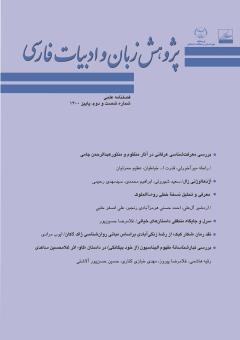بررسي تبارشناسانۀ مفهوم اليناسيون (ازخودبيگانگي) در داستان «گاو» اثر غلامحسين ساعدي
محورهای موضوعی : ادبیات انقلاب اسلامی و دفاع مقدس
رقیه هاشمی
1
![]() ,
غلامرضا پیروز
2
,
مهدی خبازی کناری
3
,
حسین حسنپور
4
,
غلامرضا پیروز
2
,
مهدی خبازی کناری
3
,
حسین حسنپور
4
1 - دانش آموخته دکتری زبان و ادبیات فارسی، دانشگاه مازندران
2 - دانشیار گروه زبان و ادبیات فارسی، دانشگاه مازندران
3 - دانشیار گروه فلسفه، دانشگاه مازندران، ایران
4 - دانشیار گروه زبان و ادبیات فارسی، دانشگاه مازندران
کلید واژه: ازخودبیگانگی, تبارشناسي, قدرت و ایدئولوژی, هویت و دیگری, داستان «گاو».,
چکیده مقاله :
پدیدۀ بیگانگی با توجه به تقابل سنت و تجدد، بهویژه در عصر پهلوی، با جریان شبهمدرنیته و جریان های سیاسی و فكري آن روزگار از وجود ارتباط معناداری حکایت میکند؛ چنان که کودتای 28 مرداد 1332 مهم ترین و تأثیرگذارترین رخداد سیاسی بود که یأس، ناکامی و ازخودبیگانگی قشر متوسط و روشنفکر جامعه را رقم زد. بنابراين پرداختن به آثار غلامحسین ساعدی به عنوان روشنفكري که سطوح و وجوهی از این پدیده را نمایندگی می کند، ضرور به نظر ميرسد؛ زيرا ادبیات او محصول فضایی است که به ساحت شبهمدرنیته در ایران تعلق دارد. مقالۀ پيش رو بر آن است داستان «گاو» ساعدی (از مجموعه عزاداران بيل) را که داستانی استعاری و سمبولیک است، بر اساس مفهوم ازخودبيگانگي تبيين و تحليل كند و ماجرای ازخودبیگانگی انسان ایرانی را در مواجهه با پذيرش واقعیت و نقش وارونتابی ایدئولوژی در ايجاد اين پديده نشان دهد. این پژوهش پس از تبیین پديدۀ اليناسيون بر اساس تبارشناسي اين مفهوم، به مدد استعارههایی چون «قدرت و ايدئولوژي»، «هویت» و «دیگری»، با توجه به ساختار نظريۀ بيگانگي هگل (يگانگي/ بيگانگي/ رهايي از بيگانگي) داستان «گاو» را بررسی می کند. طي تحليل داستان اين نتيجه حاصل شد كه در ژرفساخت اثر یک نظرگاه فلسفی-روانشناختی- جامعهشناختی پنهان است که در ساختار، فضا و شخصیت داستان قابل رؤيت است. خلق شخصیتهای مسئلهداري همچون شخصيت مشدي حسن نمایانگر جستوجوی نویسنده برای نشان دادن جهان نمادینی است که با نظريه گره خورده است.
The phenomenon of alienation according to the contrast between tradition and modernity, especially in Pahlavi era should have a meaningful relationship with the quasi-modernity flow and other intellectual and political flows. As the coup occurred in 28 Mordad 1332 was the most important and effective political flow that caused despair and failure and alienation in the middle and intellectual strata of society. So, it seems necessary to address the works of Gholam Hossein Saedi as an intellectual who represents the levels and aspects of this phenomenon. Because his literature is the product of a space that belongs to the field of quasi-modernity in Iran. This article tries to analyze and explain the story of "Cow" by Saedi (Bill Mourners Collection) which is in the form of a metaphorical and symbolic story, on the basis of alienation concept, and show the adventure of being alienation of Iranian human while facing reality, and also the role of inverted ideology in creation of this phenomenon. The research in question, after explaining the phenomenon of alienation based on genealogy of this concept shows its historical evolution in the views of Hegel and Feuerbach and Marx and Forum, examines the story of "Cow" according to metaphors such as "power and ideology", "identity", "another one". During the analysis of the story, we came to the conclusion that there is a hidden philosophical-psychological-sociological theory in the construction of the work that is visible in the structure, space and character of the story. Creating problematic characters like Mashdi Hassan, represents the author search to show a symbolic world tied to theory.
